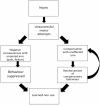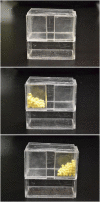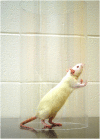Animal models of post-ischemic forced use rehabilitation: methods, considerations, and limitations
- PMID: 23343500
- PMCID: PMC3605246
- DOI: 10.1186/2040-7378-5-2
Animal models of post-ischemic forced use rehabilitation: methods, considerations, and limitations
Abstract
Many survivors of stroke experience arm impairments, which can severely impact their quality of life. Forcing use of the impaired arm appears to improve functional recovery in post-stroke hemiplegic patients, however the mechanisms underlying improved recovery remain unclear. Animal models of post-stroke rehabilitation could prove critical to investigating such mechanisms, however modeling forced use in animals has proven challenging. Potential problems associated with reported experimental models include variability between stroke methods, rehabilitation paradigms, and reported outcome measures. Herein, we provide an overview of commonly used stroke models, including advantages and disadvantages of each with respect to studying rehabilitation. We then review various forced use rehabilitation paradigms, and highlight potential difficulties and translational problems. Lastly, we discuss the variety of functional outcome measures described by experimental researchers. To conclude, we outline ongoing challenges faced by researchers, and the importance of translational communication. Many stroke patients rely critically on rehabilitation of post-stroke impairments, and continued effort toward progression of rehabilitative techniques is warranted to ensure best possible treatment of the devastating effects of stroke.
Figures






Similar articles
-
Does motivation matter in upper-limb rehabilitation after stroke? ArmeoSenso-Reward: study protocol for a randomized controlled trial.Trials. 2017 Dec 2;18(1):580. doi: 10.1186/s13063-017-2328-2. Trials. 2017. PMID: 29197412 Free PMC article. Clinical Trial.
-
Regenerative Rehabilitation for Stroke Recovery by Inducing Synergistic Effects of Cell Therapy and Neurorehabilitation on Motor Function: A Narrative Review of Pre-Clinical Studies.Int J Mol Sci. 2020 Apr 29;21(9):3135. doi: 10.3390/ijms21093135. Int J Mol Sci. 2020. PMID: 32365542 Free PMC article. Review.
-
Constraint-induced movement therapy for rehabilitation of arm dysfunction after stroke in adults: an evidence-based analysis.Ont Health Technol Assess Ser. 2011;11(6):1-58. Epub 2011 Nov 1. Ont Health Technol Assess Ser. 2011. PMID: 23074418 Free PMC article.
-
A novel approach to induction and rehabilitation of deficits in forelimb function in a rat model of ischemic stroke.Acta Pharmacol Sin. 2013 Jan;34(1):104-12. doi: 10.1038/aps.2012.106. Epub 2012 Oct 29. Acta Pharmacol Sin. 2013. PMID: 23103624 Free PMC article.
-
Translating experimental evidence to finding novel ways to promote motor recovery in stroke patients - a review.Restor Neurol Neurosci. 2018;36(4):519-533. doi: 10.3233/RNN-180814. Restor Neurol Neurosci. 2018. PMID: 29889087 Review.
Cited by
-
Rapamycin Reduced Ischemic Brain Damage in Diabetic Animals Is Associated with Suppressions of mTOR and ERK1/2 Signaling.Int J Biol Sci. 2016 Jul 18;12(8):1032-40. doi: 10.7150/ijbs.15624. eCollection 2016. Int J Biol Sci. 2016. PMID: 27489506 Free PMC article.
-
Angiogenin in the Neurogenic Subventricular Zone After Stroke.Front Neurol. 2021 Jun 21;12:662235. doi: 10.3389/fneur.2021.662235. eCollection 2021. Front Neurol. 2021. PMID: 34234733 Free PMC article.
-
Criteria for assessing peripheral nerve injury. Behavioral and functional assessment in non-operated Wistar rats.Acta Cir Bras. 2020;35(7):e202000702. doi: 10.1590/s0102-865020200070000002. Epub 2020 Aug 17. Acta Cir Bras. 2020. PMID: 32813758 Free PMC article.
-
Therapeutics with SPION-labeled stem cells for the main diseases related to brain aging: a systematic review.Int J Nanomedicine. 2014 Aug 11;9:3749-70. doi: 10.2147/IJN.S65616. eCollection 2014. Int J Nanomedicine. 2014. PMID: 25143726 Free PMC article.
References
-
- Roger VL, Go AS, Lloyd-Jones DM, Adams RJ, Berry JD, Brown TM, Carnethon MR, Dai S, De Simone G, Ford ES, Fox CS, Fullerton HJ, Gillespie C, Greenlund KJ, Hailpern SM, Heit JA, Ho PM, Howard VJ, Kissela BM, Kittner SJ, Lackland DT, Lichtman JH, Lisabeth LD, Makuc DM, Marcus GM, Marelli A, Matchar DB, McDermott MM, Meigs JB, Moy CS. Heart disease and stroke statistics--2011 update: a report from the American Heart Association. Circulation. 2011;123:e18–e209. doi: 10.1161/CIR.0b013e3182009701. et al. - DOI - PMC - PubMed
-
- Stroke statistics. [ http://www.heartandstroke.pe.ca/site/c.inKLKROwHqE/b.3646337/k.3514/Stat...]
LinkOut - more resources
Full Text Sources
Other Literature Sources

